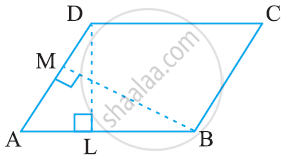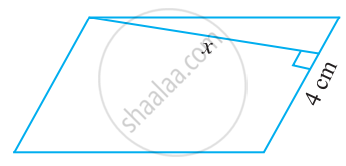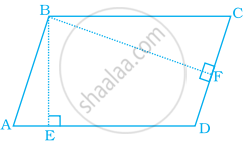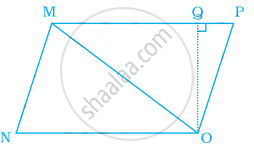Advertisements
Advertisements
Question
If base of a parallelogram is 18 cm and its height is 11 cm, find its area.
Solution
Given, base = 18 cm, height = 11 cm
Area of a parallelogram = `"Base" xx "height"`
= `18 xx 11`
= 198 cm²
∴ Area of the parallelogram is 198 sq.cm.
RELATED QUESTIONS
PQRS is a parallelogram (see the given figure). QM is the height from Q to SR and QN is the height from Q to PS. If SR = 12 cm and QM = 7.6 cm. Find:
- the area of the parallelogram PQRS
- QN, if PS = 8 cm

DL and BM are the heights on sides AB and AD respectively of parallelogram ABCD (see the given figure). If the area of the parallelogram is 1470 cm2, AB = 35 cm and AD = 49 cm, find the length of BM and DL.

Find the height ‘x’ if the area of the parallelogram is 24 cm2 and the base is 4 cm.

Find the missing values.
| Base | Height | Area |
| 8 cm | 56 sq.m |
Suresh on a parallelogram-shaped trophy in a state level chess tournament. He knows that the area of the trophy is 735 sq.cm and its base is 21 cm. What is the height of that trophy?
The area of parallelogram whose base 10 m and height 7 m is
Area of parallelogram ABCD (see the figure) is not equal to ______.

Ratio of area of ∆MNO to the area of parallelogram MNOP in the same figure is ______.

If the sides of a parallelogram are increased to twice its original lengths, how much will the perimeter of the new parallelogram?
In the given figure, find the area of parallelogram ABCD, if the area of shaded triangle is 9 cm2.

